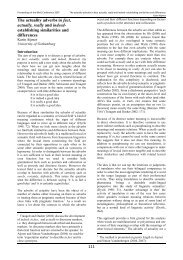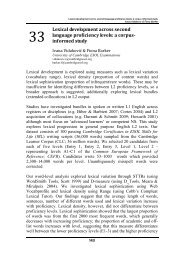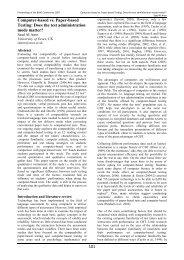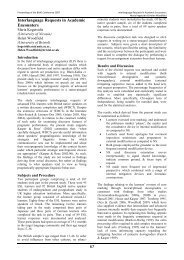Colloquia - British Association for Applied Linguistics
Colloquia - British Association for Applied Linguistics
Colloquia - British Association for Applied Linguistics
You also want an ePaper? Increase the reach of your titles
YUMPU automatically turns print PDFs into web optimized ePapers that Google loves.
BAAL Conference 2004 37 th Annual BAAL Meeting<br />
The contribution of applied linguists and language testers in developing the Common<br />
European Framework of Reference <strong>for</strong> Languages<br />
Neil Jones and Dr Lynda Taylor<br />
Research and Validation Group, ESOL Examinations, University of Cambridge<br />
Jones.N@ucles.org.uk<br />
taylor.l@ucles.org.uk<br />
In 2001 the Council of Europe published the Common European Framework of Reference <strong>for</strong><br />
Languages: Learning, teaching, assessment. The Framework document is 'a comprehensive model of<br />
language use and the language user, drawing attention ... to the relevance of the different components<br />
of the model to language learning, teaching and assessment'. It articulates a model of language and<br />
language use which draws heavily on work done within the field of applied linguistics over the past 30<br />
years.<br />
Since 2001 the Common European Framework (CEF) has become increasingly influential within<br />
Europe as national education authorities and other agencies adopt it <strong>for</strong> pedagogical and/or sociopolitical<br />
purposes, mainly in order to set and attain target language proficiency levels. The CEF now<br />
impacts directly on policy-making, syllabus design, curriculum development, pedagogy and<br />
assessment practice in countries throughout Europe.<br />
However, attempts to link per<strong>for</strong>mance in language exams to CEF levels have led several researchers<br />
to question both its theoretical status and its practical utility <strong>for</strong> this purpose. They have found its scale<br />
descriptors inadequate as construct definitions, being too underspecified to be useful <strong>for</strong> constructing<br />
tests or interpreting per<strong>for</strong>mance.<br />
This paper discusses the contribution that language testers can make to the CEF. Firstly, a constructled<br />
approach to language test construction can address the issue of scaling, i.e. the construction of<br />
dimensions of language proficiency clearly described in terms of task features. Secondly, work to<br />
interpret test per<strong>for</strong>mance -in 'can do' terms- provides a level of functional equivalence which enables<br />
equating across different languages. Assigning learners to CEF levels, on the basis of their test<br />
per<strong>for</strong>mance, is the final step.<br />
Discoursal Celebration of Ethnic and Gendered Cultural Capital: Japanese-Caucasian Hybrid<br />
Adolescent Girls in Japan<br />
Laurel Diane Kamada<br />
Aomori Akenohoshi College<br />
laurelkamada@hotmail.com<br />
Europe has been dynamically reconfigured over the last century by active movements of hybrid<br />
peoples. Movements of European peoples continue to expand into regions that have as yet not been<br />
well researched. This paper contributes to research on discoursal approaches to analyzing hybrid<br />
identities in Europe through examination of a non-European model: Japan. This presentation analyzes<br />
in<strong>for</strong>mal focus group talk of a network of six Japanese-Caucasian adolescent girlfriends residing in<br />
Japan since birth, all attending different Japanese (regular) schools, drawing on discursive psychology<br />
discourse analysis (Edwards & Potter, 1991; Potter & Wetherell, 1987, Wetherell, & Potter, 1992;<br />
2001; Wetherell, 1998; Potter & Edwards; 2001, Billig, 2001; Edwards & Potter, 1992). All of the girls<br />
have one Japanese parent and one <strong>for</strong>eign born/raised English-speaking Caucasian parent from<br />
Britain, America, or Australia. This paper examines how these girls, with their double-dominance<br />
(indigenous and white-western heritages), construct the notion of cultural capital as a self-enhancing<br />
discursive resource. They discursively celebrate their multi-ethnic and gendered cultural capital,<br />
backgrounded by their positioning in a society where a dominant hegemonic discourse denies the<br />
existence of heterogeneity and where they are socially positioned as the other and referred to as<br />
haafu (half).Examples of multi-ethnic cultural capital which these girls discursively construct <strong>for</strong><br />
themselves include bilinguality, biliteracy, global savvy, femininity and means of access to a world<br />
beyond the national borders where one was born (including access to high-status English proficiency,<br />
connections, in<strong>for</strong>mation). These girls are not only able to successfully take control of constituted<br />
subject positionings by use of rhetorical devices to explore, reject, confront, contest and alter subject<br />
positions, but more specifically, I will demonstrate how they discursively confront power positions of<br />
various actors in their worlds by (re)constituting themselves via rhetorical constructions which boost<br />
their self-confidence and pride in their possession of many kinds of multi-ethnic and feminine cultural<br />
capital.<br />
King‟s College, London 9 – 11 th - 16 -<br />
September, 2004







